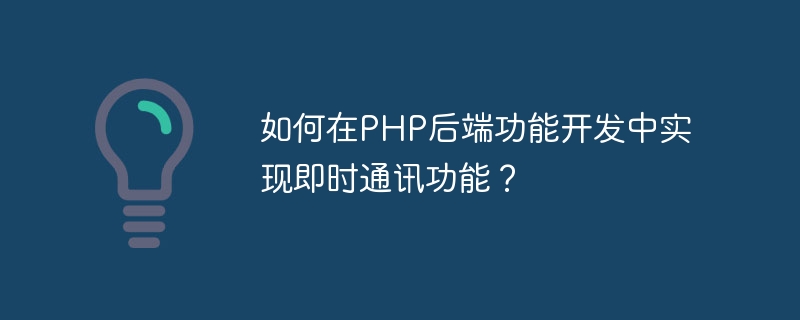

How to implement instant messaging function in PHP back-end function development?
Foreword:
With the rapid development of the mobile Internet, instant messaging has become an important way for people to communicate in daily life. How to implement instant messaging function in PHP back-end function development? This article will introduce an implementation method based on WebSocket and PHP, and provide corresponding code examples.
1. Introduction to WebSocket
WebSocket is a protocol for full-duplex communication on a single TCP connection. Compared with the traditional HTTP protocol, WebSocket has the characteristics of good real-time performance, high performance, and low latency, and is very suitable for implementing instant messaging functions.
2. Server environment construction
Installing the WebSocket library
In PHP development, we can use the Ratchet library to implement the WebSocket function. The Ratchet library can be installed through Composer. The specific installation command is as follows:
composer require cboden/ratchet
Create a WebSocket server
We can create a server.php file as a WebSocket server. The specific code is as follows:
<?php
require 'vendor/autoload.php';
use RatchetConnectionInterface;
use RatchetMessageComponentInterface;
use RatchetServerIoServer;
use RatchetHttpHttpServer;
use RatchetWebSocketWsServer;
class Chat implements MessageComponentInterface {
protected $clients;
public function __construct() {
$this->clients = new SplObjectStorage;
}
public function onOpen(ConnectionInterface $conn) {
$this->clients->attach($conn);
echo "New client connected: {$conn->resourceId}
";
}
public function onMessage(ConnectionInterface $from, $msg) {
echo "Received message from {$from->resourceId}: {$msg}
";
// 在这里可以对消息进行处理,如保存到数据库、发送给其他连接等
}
public function onClose(ConnectionInterface $conn) {
$this->clients->detach($conn);
echo "Client disconnected: {$conn->resourceId}
";
}
public function onError(ConnectionInterface $conn, Exception $e) {
echo "An error occurred: {$e->getMessage()}
";
$conn->close();
}
}
$server = IoServer::factory(
new HttpServer(
new WsServer(
new Chat()
)
),
8080
);
$server->run();This code creates a Chat class and implements the MessageComponentInterface interface. In the onOpen method, we add the new connection to the clients list and output the resource ID of the connection; in the onMessage method, we can Process the message, such as saving it to the database, sending it to other connections, etc.; in the onClose method, we remove the disconnected connection from the clients list and output the disconnected Resource ID; in the onError method, we can handle the error. Finally, we use IoServer to create a WebSocket server and listen to port 8080.
3. Client implementation
We can use HTML and JavaScript to implement the client function of WebSocket. The following is a simple example:
<!DOCTYPE html>
<html>
<head>
<title>WebSocket Test</title>
</head>
<body>
<div id="message-container"></div>
<input type="text" id="message-input">
<button onclick="sendMessage()">Send</button>
<script>
var websocket = new WebSocket('ws://localhost:8080');
websocket.onopen = function(event) {
console.log('WebSocket connected');
};
websocket.onmessage = function(event) {
var messageContainer = document.getElementById('message-container');
var newMessage = document.createElement('div');
newMessage.innerHTML = event.data;
messageContainer.appendChild(newMessage);
};
function sendMessage() {
var messageInput = document.getElementById('message-input');
var message = messageInput.value;
websocket.send(message);
messageInput.value = '';
}
</script>
</body>
</html>This code creates a WebSocket object and specifies the connection to ws://localhost:8080, the server created earlier. In the onopen event, we can perform some initialization operations; in the onmessage event, we can process the message received from the server and add it to the page; in the sendMessage In the function, we can send messages to the server. There is an input box and a button on the page that can be used to enter and send messages.
4. Run and test
Start the WebSocket server
Switch to the project directory on the command line and execute the following command to start the WebSocket server:
php server.php
At this point the server has been started successfully and can receive and send messages.
Conclusion:
Through the above steps, we successfully implemented the instant messaging function using WebSocket in PHP back-end development. WebSocket can realize real-time and efficient message transmission and is suitable for the development of various instant messaging applications. I hope this article can be helpful to everyone.
The above is the detailed content of How to implement instant messaging function in PHP back-end function development?. For more information, please follow other related articles on the PHP Chinese website!
 How to open php file
How to open php file
 How to implement instant messaging on the front end
How to implement instant messaging on the front end
 How to remove the first few elements of an array in php
How to remove the first few elements of an array in php
 What to do if php deserialization fails
What to do if php deserialization fails
 How to connect php to mssql database
How to connect php to mssql database
 How to connect php to mssql database
How to connect php to mssql database
 How to upload html
How to upload html
 How to solve garbled characters in PHP
How to solve garbled characters in PHP